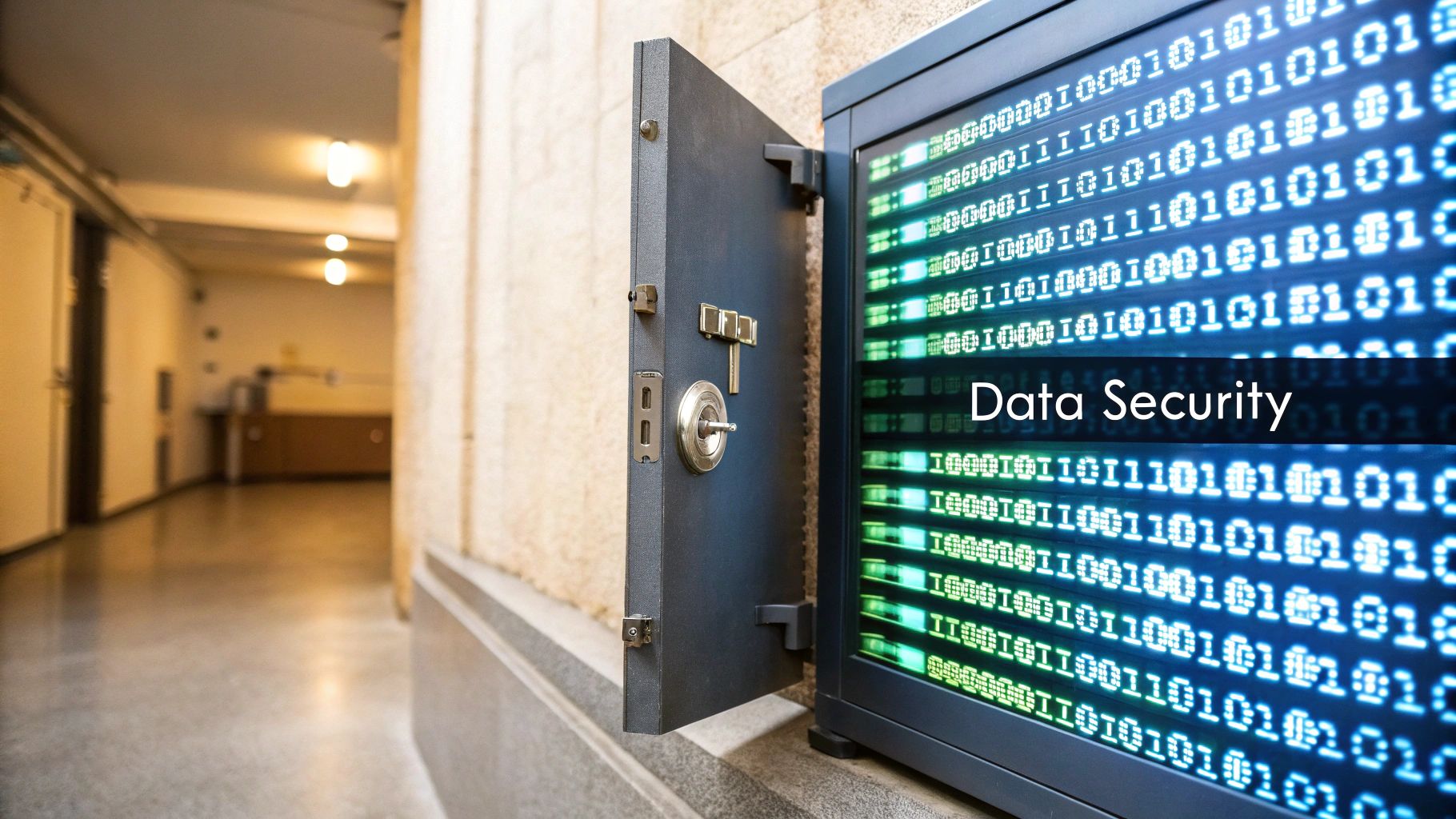The Critical Importance of Data Encryption: A Modern Guide to Protecting Your Digital World
Building Your Data Protection Foundation

Data encryption plays a key role in keeping information secure. When data is encrypted, it's converted from readable text into scrambled code that can only be decoded with the right key. This means that even if someone manages to steal encrypted data, they won't be able to read or use it without proper authorization. Let's explore how to build strong data protection through smart encryption practices.
Understanding the Core Principles of Data Encryption
Encryption does more than just scramble data – it provides essential protection against real security threats. Without it, sensitive information like financial records, personal details, and business secrets are at risk of theft and misuse. For example, when a company stores customer credit card numbers, encryption ensures this data stays safe even if their systems are breached. Beyond security, encryption helps organizations meet important data privacy rules and regulations that govern how sensitive information must be handled.
Why Encryption is Non-Negotiable in Today's World
As more of our information moves online, strong encryption becomes increasingly important. The sheer amount of data being created and shared digitally makes it an appealing target for cybercriminals. But encryption isn't one-size-fits-all – different situations need different approaches. For instance, data that's being stored (like files on a hard drive) requires different protection than data being sent over networks. Getting these details right is crucial for building reliable security.
Selecting the Right Encryption Method: A Practical Guide
When choosing an encryption approach, you need to consider what you're protecting and how much security you need. The two main types are symmetric and asymmetric encryption. Symmetric uses one key for both locking and unlocking data, while asymmetric uses separate public and private keys.
| Encryption Type | Advantages | Disadvantages |
|---|---|---|
| Symmetric | Faster and more efficient | Key distribution can be challenging |
| Asymmetric | Enhanced security and easier key management | Slower than symmetric encryption |
The growth of cloud services and mobile devices makes encryption even more critical. These systems often handle sensitive data while connecting through potentially insecure networks. Recent data breaches show the high cost of poor security – with companies facing millions in damages after incidents. By implementing strong encryption early, organizations can avoid these expensive problems and protect both their data and reputation.
The Real Cost of Inadequate Protection
Strong data encryption isn't just good practice – it's essential for business survival. When organizations fail to properly secure their data, they face serious financial and reputational consequences that can impact them for years to come. Let's examine the true costs of insufficient protection.
The Financial Fallout of Data Breaches
The numbers tell a sobering story. According to recent research, data breaches now cost companies an average of $4.88 million in 2024. This includes direct expenses like legal fees, regulatory fines, and breach notifications, as well as the costs of fixing compromised systems. Companies also lose significant revenue from business disruptions and customers taking their business elsewhere.
Beyond the Bottom Line: Reputational Damage and Loss of Trust
Money is just part of the equation. Once a data breach occurs, an organization's reputation often takes a severe hit. Customers who trusted the company with their sensitive information feel betrayed, leading them to switch to competitors. This erosion of trust hits particularly hard in sectors like healthcare and financial services, where data security is paramount to the business relationship.
Hidden Costs: Operational Disruption and Recovery Efforts
The aftermath of a breach creates major operational headaches too. Companies often need to shut down critical systems during investigation and recovery, grinding business to a halt. Getting everything back up and running properly takes considerable time and resources. These disruptions mean missed opportunities, reduced productivity, and frustrated customers.
Calculating Your Risk Exposure: A Proactive Approach to Security
Smart organizations take time to understand their specific risks before problems occur. This means carefully reviewing what types of data they handle, considering how damaging a breach would be, and realistically assessing their likelihood of being targeted. With this clear picture, they can make smart choices about encryption and other security measures.
Case Studies: Lessons Learned From Security Failures and Successes
Real examples drive home the importance of proper encryption. Consider the healthcare industry – in 2023 alone, 725 data breaches exposed over 133 million patient records. While some organizations have successfully defended against attacks through strong encryption, others paid a heavy price for weak security. These stories offer valuable lessons about the need for robust protection in an environment where threats constantly evolve. By studying both failures and successes, businesses can better prepare their defenses and keep their sensitive data safe.
Breaking Down Common Security Myths
After examining the real costs of poor data protection, it's time to tackle some widespread misconceptions about security. Many organizations fall into the trap of believing these myths, which can create dangerous gaps in their defenses. Let's examine the truth behind these common beliefs to help you build stronger data protection.
Myth 1: Complex Passwords Are Enough
While creating strong passwords is important, thinking they provide complete protection is a serious mistake. Even the most complex passwords can be exposed through phishing attacks or brute-force methods. Think of it like having a high-security lock on your front door while leaving your windows wide open – attackers will simply find another way in. This is why data encryption is essential – it ensures that even if passwords are stolen, the protected information remains unreadable and useless to criminals.
Myth 2: Encryption Slows Down Performance
Many people worry that encryption will significantly reduce their system speed. The truth is that modern encryption has minimal impact on performance. Thanks to better technology, like dedicated encryption processors in newer devices, the process happens quickly and efficiently in the background. Most users won't notice any difference in their day-to-day work, making the security benefits well worth the tiny processing overhead.
Myth 3: Small Businesses Don't Need Encryption
Some smaller companies think their size protects them from cyber attacks. In reality, smaller businesses are popular targets precisely because they often have weaker security. Data shows that small and medium businesses face a large portion of all cyber attacks. Plus, failing to encrypt data can lead to heavy fines for breaking privacy regulations – costs that could seriously damage a small company's finances.
Myth 4: Antivirus Software Guarantees Data Security
While antivirus software helps protect against known threats, it's just one piece of the security puzzle. Modern attacks, especially ransomware, are often able to slip past antivirus defenses. Encryption provides an essential extra layer of protection – even if malware infects your system, properly encrypted data stays safe and unreadable. This shows why a multi-layered approach using both antivirus and encryption is crucial for real security.
Myth 5: Encryption is Too Complex to Implement
Many businesses avoid encryption because they think it's too difficult to set up. However, today's encryption tools are designed to be straightforward and user-friendly. Many popular software packages and cloud services now include built-in encryption features that anyone can use. For companies wanting extra help, security service providers can handle the entire setup and management process. This makes strong encryption protection accessible to organizations of any size or technical skill level.
Protecting Sensitive Industry Data
Every industry faces unique data security needs that require careful planning and specific encryption approaches. Understanding exactly what kinds of data your organization handles and how it needs to be protected is essential for building an effective security strategy. Here's how different sectors are approaching their data encryption needs.
Healthcare: Safeguarding Patient Confidentiality
Hospitals and medical facilities manage extremely sensitive patient information that requires robust protection. Medical records contain everything from personal health histories to current treatment plans – data that must remain private to maintain patient trust and meet HIPAA requirements. Recent breaches highlight the critical nature of this need – in 2023, over 133 million patient records were exposed across 725 separate incidents. This is why healthcare organizations encrypt all patient data, ensuring it stays secure even if their systems are compromised.
Finance: Securing Financial Transactions
Banks and financial companies handle massive amounts of sensitive customer data every day. From account numbers to transaction records, this information requires airtight protection against fraud while meeting standards like PCI DSS. For example, when you make an online purchase, your credit card details and banking credentials are encrypted during the transaction and in storage. With data breaches now costing financial institutions an average of $4.88 million in 2024, strong encryption isn't just good security – it's a business necessity.
Technology: Protecting Intellectual Property
Tech companies face constant threats to their valuable intellectual property. Source code, proprietary algorithms, and confidential business plans all need protection from theft and unauthorized access. This means encrypting data both while it's stored (at rest) and when it's moving between systems (in transit). Many tech firms also use encryption to protect user data and ensure customer privacy.
Implementing Industry-Specific Encryption Strategies
While each industry has its own needs, some core principles apply when choosing encryption methods. Consider these key factors:
- Data at Rest: Protect stored data using full-disk or file-level encryption on servers and devices
- Data in Transit: Secure information moving across networks with TLS/SSL, especially for web and email traffic
- Cloud Storage: Work with providers that offer strong encryption for both stored data and transfers
Good encryption is just one part of a complete security approach. Combined with strong passwords and multi-factor authentication, it creates solid protection against emerging threats. By making data security a priority, organizations show their commitment to protecting sensitive information while building customer trust. Understanding and following the specific encryption rules for your industry also helps avoid costly compliance violations. This thoughtful approach to data protection helps secure both your sensitive information and your organization's future success.
It's more conversational and human-like while maintaining the key information:
Building Human-Centric Security
Strong data encryption is essential for security, but even the best technical defenses can fail if we overlook the human side of things. While encryption tools and protocols matter, what's equally important is creating an environment where everyone understands and actively participates in security practices. The real challenge lies in making encryption both robust and easy for people to use in their daily work.
Engaging Your Team: The Key to Successful Encryption
Consider a real-world scenario: A company invests heavily in advanced encryption systems but skips proper password training for their staff. One weak password could open the door to hackers, making those expensive security measures useless. This shows why ongoing training matters so much. Good security education should cover the basics – from creating strong passwords to spotting suspicious emails – while helping everyone understand why protecting sensitive data is crucial for the company's success.
Simple tools can make a big difference in encouraging secure behavior. Adding two-factor authentication, sending regular security updates, and making everyone feel responsible for security helps build better habits. It's worth noting that 74% of data breaches involve human error, which shows just how important it is to focus on the people using these systems.
Access Control: Balancing Security and Usability
Getting access control right is another key piece of the puzzle. The basic idea is simple: give people access only to what they need for their jobs. This way, if someone's account gets compromised, the damage is limited. But there's a catch – make the rules too strict, and people can't do their work efficiently. The trick is finding the sweet spot where security and practicality meet.
Regular checks of who has access to what are essential, especially as people change roles or leave the company. Good monitoring systems that track how sensitive data is being used can help catch potential problems early.
Building a Security-Conscious Culture
At its heart, effective encryption depends on creating a culture where security matters to everyone. This means more than just teaching people about security – it's about giving them the right tools and making them feel comfortable reporting concerns. When employees understand how their actions protect both the company and its clients, they're more likely to take security seriously.
Simple things like regular security awareness campaigns keep important messages fresh in people's minds. Recognizing employees who follow good security practices can encourage others to do the same. A disturbing finding from a 2019 study showed that 53% of companies had over 1,000 sensitive files sitting unprotected – highlighting why we need to make security a natural part of how everyone works. When you invest in helping people understand and care about security, you not only protect your data better but also build trust with both employees and customers.
Creating Your Encryption Success Roadmap
Creating a solid data encryption strategy requires careful planning and ongoing attention. After grasping why encryption matters and moving past common misconceptions, organizations need a clear action plan to implement and maintain their security measures. Here's how to build an effective roadmap for encryption success.
Assessing Your Current Security Posture
Start by taking inventory of your organization's data and security measures. Map out what types of information you handle – from customer records to internal documents – and identify where this data lives and how it moves through your systems. For example, sensitive data like customer payment details needs much stronger protection than public marketing materials. This assessment helps you understand where to focus your encryption efforts first.
Identifying Critical Gaps and Building an Encryption Framework
With a clear view of your data environment, examine where your current security falls short. Look for unencrypted sensitive data or outdated encryption methods that need upgrading. Your encryption framework should match different protection levels to different types of data while staying flexible enough to grow with your organization. Just as a house needs a solid foundation, your encryption approach must be built on thorough planning and assessment.
Practical Implementation Timelines and Success Metrics
Break down your encryption rollout into manageable phases instead of trying to do everything at once. Start with your most sensitive systems and data, then expand from there. For instance, begin by encrypting stored data on critical servers before moving on to data in transit. Set clear benchmarks to measure progress, such as the amount of sensitive data encrypted or improvements in breach detection time. These metrics show the real impact of your encryption efforts and help justify ongoing investment.
Monitoring Strategies for Continuous Improvement
Getting encryption in place is just the beginning – you need to keep watching and adjusting your approach. Regularly check that your encryption methods still match your needs and protect against current threats. Update your encryption tools, follow security best practices, and schedule regular security reviews. Think of it like maintaining your car – routine checks prevent problems and keep everything running smoothly. Have clear steps ready in case of security incidents so you can respond quickly and minimize any damage.
To help monitor and improve your web application's security and performance, consider using DebugBar – a development tool that helps teams identify and fix issues before they become problems.
Check out DebugBar to learn more about strengthening your web application security.



Comments
Leave a comment